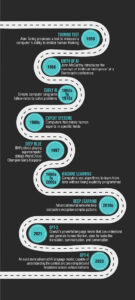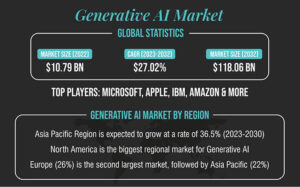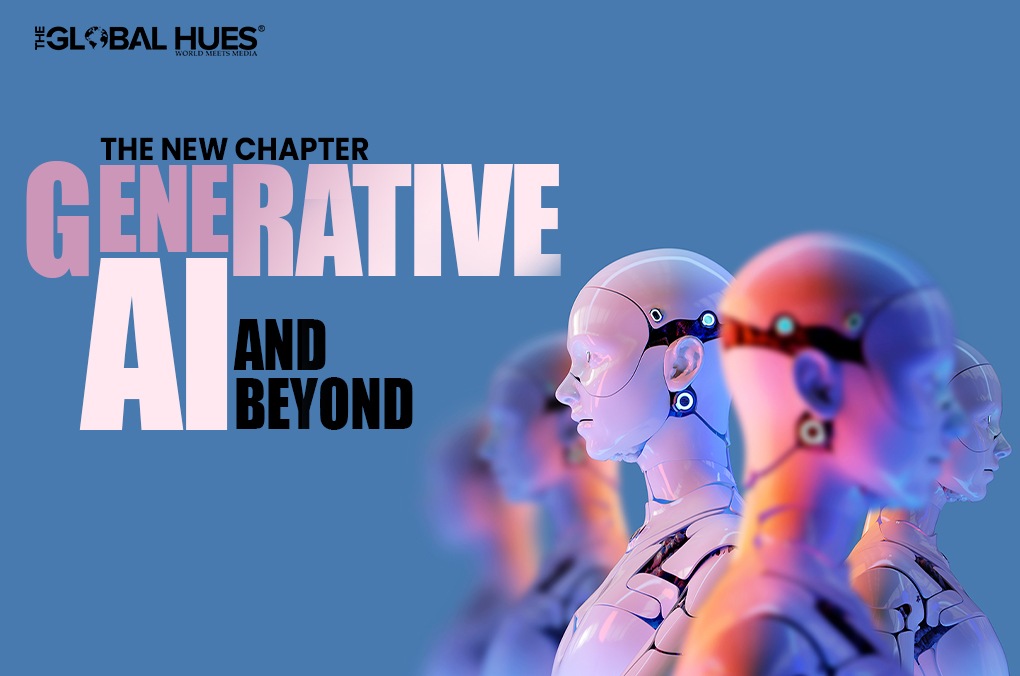Did you ever imagine a world where you would simply send a few instructions to a computer program and you would get new, original illustrations, text and videos? Well, this is the world of Generative AI, and in 2023, it has become a prominent force with the emergence of tools such as ChatGPT, Bing Chat, and Google’s Bard. In January 2023, ChatGPT crossed the milestone of 100 million active users, a figure that surged to 180.5 million by August 2023, as reported by Reuters. As the adoption of Generative AI increases, so does the creation of more and more synthetic media i.e. AI-generated videos, texts, and audio.

But how does this system work?
Have you heard of Machine Learning? If so, understanding this concept would be very easy for you. The generative AI system is developed with a technique called machine learning, which involves teaching an AI to perform tasks by exposing it to lots of data, effectively ‘training’ it. What happens next? The system learns to mimic it.
For instance, consider ChatGPT; it’s a perfect example. This AI tool is trained on lots and lots of data available on the internet. How does it manage to imitate human language? It is trained with scripts of dialogue. Another example is Adobe Firefly which offers new ways to ideate, create and communicate and allows you to improve creative workflows using generative AI.

Generative AI Trends
Undoubtedly, we are sure to experience exciting developments in the field of generative AI that would reshape industries, revolutionise creative processes and enhance our daily lives. Here are some generative AI trends for 2024 and the years to come.
-
Machines Would Feel Like Humans
Although conversational AI has left all of us spellbound, the future expects more lifelike context-aware chatbots and virtual assistants. That would mean AI responding to natural language in a much better way. Imagine you are talking to a machine but feel like it’s a human you are talking to.
-
New Possibilities of Storytelling
With the help of AI, one can make visually appealing videos but imagine when AI would enable filmmakers to create not only entirely synthetic actors but also scenes, and special effects, that too indistinguishable from reality.
-
New Dimensions To Music, Art & Literature
Generative AI will add more to the art, music and literature industry by creating highly personalised content for users. By using data to generate content, AI will help in the creation of customised news articles, customised product recommendations and personalised art and music.
-
A Revolution In The Field of Education
Think of how AI -tutors and educational content generators can make the lives of both teachers and students easier. Creating exercises, quizzes, and projects for students that are personalised depending on the student’s current skill will foster better learning experiences.
-
Creation of Visually Appealing Products
As generative AI can generate creative ideas and concepts very rapidly, it can help product engineers use machine learning algorithms to design new product features and designs. This would lead to the creation of more user-friendly and visually appealing products.
-
Contribution to Saving Lives
Generative AI will transform healthcare in the future by aiding drug discovery, diagnostics and treatment planning. As it will continue to improve the accuracy of medical imaging and predict disease outbreaks, it will help save lives.
Utpal Chakraborty
Gartner Ambassador 2023 Data & Analytics, CTO IntellAI, AI Global Ambassador, an Eminent Data Scientist and Author of 7 Books on AI & Quantum Computing

1. How do you perceive the role of human-AI collaboration in the context of Generative AI, and how can businesses strike the right balance between automation and human intervention to maximise productivity and creativity?
Human-AI collaboration is essential for the effective use of generative AI. Generative AI models can be very powerful, but they are not perfect. They can sometimes make mistakes, and they may not always be able to understand the nuances of human language and culture. Human input is needed to ensure that generative AI models are used responsibly and ethically and that the outputs of these models are accurate and relevant.
Businesses can strike the right balance between automation and human intervention in generative AI by identifying the right tasks to automate. Businesses should identify tasks that are repetitive, time-consuming, or error-prone. These are the tasks that are most suitable for automation.
Generative AI can be used to augment human capabilities, rather than replacing them altogether.
I feel, businesses should establish clear guidelines for how humans and AI will collaborate on generative AI tasks. This will help to ensure that everyone involved understands their roles and responsibilities.
2. With the rapid advancements in Generative AI, what future trends do you foresee in this field? How can businesses stay ahead of the curve to leverage these technologies?
Generative AI is a rapidly evolving field, and new trends are emerging all the time. Here are a few trends that I foresee in the future of generative AI:
Generative AI models are becoming increasingly sophisticated and versatile, capable of generating a wider range of content including text, images, code, and music. This is making them more useful for a wider range of business applications.
Also, Generative AI tools and platforms are becoming more accessible to businesses of all sizes and industries. This is making it easier for businesses to get started with generative AI and to leverage its benefits. That’s the reason Generative AI is being adopted by a growing number of businesses across a wide range of industries. This is due to the fact that generative AI can help businesses to improve their efficiency, productivity, and creativity.
Businesses should invest in research and development to stay up-to-date on the latest trends and developments in generative AI. This will help them to identify new opportunities to leverage generative AI in their businesses.
Businesses should also experiment with different generative AI tools and platforms to find the ones that best meet their needs. This will help them to get started with generative AI quickly and easily. It is advisable to partner with AI experts to help them to implement and deploy generative AI solutions. This can be a good option for businesses that do not have the in-house expertise to implement generative AI on their own.
3. What are some of the most prominent and practical use cases of Generative AI in today’s business landscape?
- Customer service: Generative AI can be used to create chatbots that can answer customer questions and provide support. This can help businesses to improve their customer service and to reduce costs.
- Content Creation- From blog posts to advertisements, Generative AI-like GPT models can produce content tailored to specific audiences.
- Design and Art- AI tools can generate illustrations, designs, and even artwork based on textual prompts.
- Music and Video Production- Generative models can compose music or generate video clips, enhancing production processes in the entertainment industry.
- Product Development- AI can suggest product designs or modifications based on consumer feedback and market trends.
- Research and development: Generative AI can be used to generate hypotheses, design experiments, and analyse data. This can help businesses to accelerate their research and development process and to gain new insights.
- Pharmaceuticals- Generative AI can aid in drug discovery by suggesting molecular structures that can be potential new drugs.
The Other Side of The Coin
Generative AI is all set to revolutionise various industries in the upcoming years, ushering in a transformative wave for business models. However, this transformation unveils a flip side, as it raises critical ethical concerns that cannot be ignored.
-
Disclosure of Sensitive Information
Generative AI is trained on huge sets of data, which makes us question the aspects of data privacy and security. There are chances that AI reproduces snippets of training data. If the training data contains sensitive information, there’s a risk of it being exposed. Furthermore, if generative AI gets its training on personal customer data without obtaining requisite permissions, it can violate privacy regulations.
-
Cybersecurity Concerns
Generative AI models, with their advanced skills like coding, can potentially end up in the hands of malicious actors, giving rise to cybersecurity concerns. While companies selling these AI solutions claim they train their models to block malicious requests, users often lack the means to confirm the effectiveness of these security measures independently.
-
Copyright and Intellectual Property Rights Issues
Copyright is one of the biggest concerns. These AI models draw upon extensive internet data for their training, which is further used to generate an output. However, this training process may lead to the use of works that haven’t been explicitly shared by the original creators. This issue becomes particularly complex when applied to AI-generated art, especially images and music.
-
Hallucinations
No matter how advanced AI models get, they can’t be humans. They always rely on training and data to provide an output. AI models can misinterpret your input or provide incorrect answers.
Ritesh Bhatia

Cybercrime & Forensics Investigator, Certified Fraud Examiner (USA) and Cybersecurity and Data Privacy Consultant
1. From a cybersecurity perspective, can you shed light on some potential risks and vulnerabilities associated with Generative AI?
Generative AI, while a revolutionary technology, poses significant cybersecurity risks and vulnerabilities. One major concern is the potential for AI-generated content to be used in malicious activities, such as creating deepfakes for identity theft or spreading disinformation. Moreover, the data used to train these models can inadvertently reveal sensitive information if not properly anonymized, making it a target for cyberattacks.
There’s also the risk of AI models being manipulated through adversarial attacks, leading to unreliable and biased outputs. As Generative AI becomes more prevalent, organisations need to prioritise robust security measures, including thorough data protection, to safeguard against these emerging threats.
2. How important is it for businesses to ensure data privacy when using Generative AI for tasks like data generation or content creation? What are the key data privacy considerations they can follow?
Ensuring data privacy is paramount when employing Generative AI for business tasks like data generation or content creation. Companies must respect user privacy and comply with relevant regulations, such as India’s Digital Personal Data Protection Act, GDPR or CCPA, to maintain trust and avoid legal repercussions. Key considerations include limiting data access, implementing strict access controls, and conducting regular audits to ensure that personal and sensitive data is not exposed.
Additionally, adopting privacy-preserving techniques like differential privacy and privacy by design can help protect individual privacy while benefiting from AI capabilities. By incorporating these measures, businesses can leverage Generative AI while upholding data privacy, which is vital for maintaining customer trust and staying compliant with evolving data protection laws.
Sumit Kumar
Youngest National Security Strategist, Working as Asst. Chief Information Security Officer and Project Manager under the Defence and Strategic Affairs wing of BECIL, Under the Ministry of Information & Broadcasting, and the Government of India

1. Can you please shed light on how businesses and organisations can harness Generative AI to stay ahead of evolving cybersecurity threats and maintain data integrity?
Terrorists, criminals, police, defence, law enforcement, engineers, creators, Doctors, instructors, and students utilise generative AI every day. Generative AI has several uses. Several inquiries emerge, such as “Generative AI will amplify today’s cybercrime “Dark side of Generative AI?” “How Generative AI Benefits Cyber Security Expert?” “Does generative AI help improve the skill of investigation agencies and Decision makers?” “How Cybersecurity Analysts Are Using Generative AI for Malicious Code Analysis, Predicting Threats,” and “Is Generative AI Bringing Advancements for Cyber Security as National Security” too.
Cybercrime increased by 600% during COVID-19. Cybercrime cost USD 6 trillion in 2021, third in the global economy after the US and China. Global cybercrime will cost $10.5 trillion by 2025.
GenAI can evaluate large datasets to reveal cybercrime tendencies including attacks, targets, and concealment. GenAI scripts and procedures help non-coders analyse big data.
GenAI may advise on hacker and intrusion prevention. Software and OS upgrades, password security, and two-factor authentication are possible.
Multiple data sets may be analysed using generative AI for safety and security. AI can identify data patterns and irregularities to improve situational awareness and threat response.
GenAI-powered chatbots or virtual assistants help firms quickly discover information. Chatbots allow staff to request training and ask policy and technique questions.
Organisations may train GenAI to decrypt encrypted communication and translate languages for businesses in real time.
Cybercrime is always changing and requires technology, awareness, education, and training. Generative AI shouldn’t replace cyber security specialists’ advice. Technology, Policy, law, and the ever-changing threat scenario make cyber security a challenging field.
2. What are the key factors that large organisations and small businesses should consider when implementing Generative AI technologies?
The potential and difficulties of generative AI are reflected in its ability to generate content by analysing and learning from existing data sets and patterns. AI-generated content is only as good as the training data it was given, no matter it’s from large organisations or small businesses. Content veracity is improved by using accurate, varied, and representative data, yet problems with data correctness and reliability continue. Syntactically correct but conceptually wrong or dishonest information can be generated by generative AI, which presents substantial issues in precision-oriented professions like law and medicine. These problems are exacerbated by outdated training data, making human verification of essential documents a must.
Bias in training data is another major issue for large organisations or small businesses. The need to tackle bias in AI-generated material to promote justice and equity is highlighted by the fact that biased data can lead to AI models repeating negative preconceptions and biases.
Generative AI, for all its flaws, has proven particularly useful in the realm of quick content development. However, it may have trouble conveying abstract concepts or technical specifics, requiring human monitoring to ensure correctness and dependability, especially in crucial areas.
There are risks associated with generative AI as well. Information security is in danger from phishing and deep fake assaults, which are difficult to spot, and they may be used to disseminate false information and create false identities for scams, automating processes, which might lead to job displacement.
3. What’s the most exciting business opportunity you see emerging from the advancement of Generative AI?
Generative AI is the wizard behind advanced chatbots and AI for conversation, which are revolutionising the way we communicate online. These computer wizards are particularly useful in social networking, online education, and customer service because of the human-like replies they can provide. They learn best in context and can have intelligible discussions because of the training they receive from chat logs.
The adaptability of Generative AI is what makes it distinct. It learns from its interactions and becomes better over time, making for increasingly relevant and exciting experiences for each user. But this magic isn’t limited to only generating words. Generative AI excels in linguistic tasks such as identifying Business strategy, Content creation, Service Support and business intelligence.
Using APIs or pre-trained models in deep learning libraries, Generative AI may be easily integrated into chatbot systems written in a variety of programming languages.
Companies are taking advantage of this trend by employing chatbots to field customer support queries and complaints. Human resources chatbots help with onboarding and other administrative tasks while sales and marketing chatbots answer questions and generate leads.
In the commercial realm, generative AI acts as the conductor, orchestrating a symphony of effective customer service, improved procedures, and reduced expenses. Its ability to mimic human communication and understand its surroundings might completely alter how we communicate in the digital age.
Last Words
It’s time that we embrace the transformative potential of generative AI with open arms but it is equally important to establish strong ethical frameworks and mechanisms for accountability. The real challenge is to balance the power of Artificial Intelligence with ethics and accountability. After all, it’s all about creating a digital world that is not only innovative but also fair and equitable.




